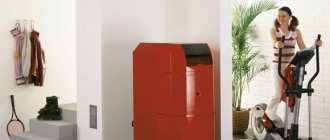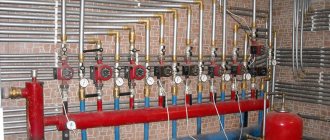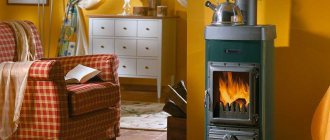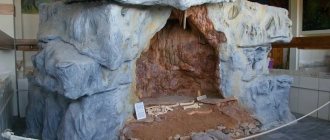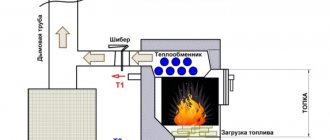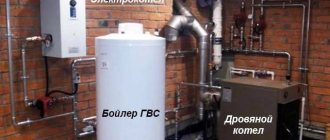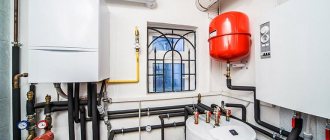In the household appliances market, the induction heating boiler remains a novelty, although the popularity of such an innovative solution is rapidly growing. Among electric boilers, induction models account for about 30%. How does this unit differ from its competitors with conventional heating elements or electrodes?
We will tell you everything about the principle of operation and the unique advantages of equipment whose operation is based on the use of induction. In our proposed article, its varieties are presented and described in detail. Our installation tips will help you easily install or upgrade the heating system of a cottage, store or warehouse.
Features of design and operation
An induction boiler is capable of generating heat and heating rooms thanks to electromagnetic induction. This physical phenomenon was discovered by Faraday during his experiments with a cylindrical magnetic bar, around which copper wire was wound in the form of a spiral.
Induction unit design
A modern induction heating boiler also includes an inductor and a core. When an alternating electric current passes through a coil, an electromagnetic field is generated.
The field generates eddy electric currents that heat the core, the heat from which is transferred to the coolant. The amount of this heat is determined by the Joule-Lenz formula.
An induction heating boiler is a complex multi-component unit. To better understand the principle of operation of an induction device, it is worth remembering the school physics course
An induction heating boiler consists of two main parts. In one of them, consisting of a coil and a core, a magnetic field is formed. The second part is a heat exchanger with working fluid (coolant).
The coolant function is performed by ordinary water or a mixture of water and ethylene glycol. It is possible to use other liquids, the choice of which depends on the specific boiler model.
A heating system with an induction boiler is always connected to a closed circuit. The installation diagram also includes a membrane tank, which is necessary to receive excess water that occurs due to its thermal expansion. If such a tank is not included in the package, it must be purchased separately.
Specifics of use in heating circuits
Induction boilers are designed to operate in a forced circulation system. Therefore, the connection diagram must include a circulation pump that stimulates the movement of the working fluid along the heating circuit.
This need is due to the relatively small volumes of heat exchangers - due to rapid heating, the water in them boils faster than gravitational circulation occurs.
Induction boilers are supplied complete with a remote control unit designed to automate the operation of heating equipment
In multi-circuit systems, circulation pumps are installed on each circuit. If the house has a heated floor system, then the package must include a distribution manifold and an additional pump.
The boiler control system includes, in addition to a thermostat and temperature sensors, a so-called safety group, which is designed to prevent overheating, excess pressure and the breaking point of parts.
The safety group usually includes a pressure gauge, air vents and safety valves. Surge protection is implemented using automatic components. Treating individual parts with a compound increases their protection. Thanks to the protection components, safe and uninterrupted operation of the boiler is ensured.
The assembly diagram of a heating system with an induction boiler must include an expansion tank and a safety group that prevents excess pressure in a closed circuit
Household induction boilers, depending on the rated power, operate on a voltage of 220 V or 380 V at a current frequency of 50 Hz. To connect an electric boiler to the network, you will need to notify the local energy company (electricity supplier) and obtain their approval.
The connection can be single- or three-phase. The wires used to connect the power supply must have the appropriate cross-section.
In an induction device, heating is controlled by cycling it on and off. This process is assisted by temperature sensors (thermocouples) included in the control system.
A cross-section of an induction boiler indicating the direction of movement of the coolant. In a cold state, the coolant enters through the lower pipe and, after heating, is supplied through the upper pipe into the heating system
The user sets the optimal temperature mode and the boiler, after heating the coolant to a certain temperature, automatically turns off, and after cooling it turns on again.
Thanks to the continuous heating cycle of the coolant, a comfortable microclimate is maintained in heated rooms. In many models, data on temperature and other operating parameters are displayed, which makes it easier to control the operation of the equipment.
Optionally, induction heating boilers are equipped with GSM modules to control the room temperature and control via a smartphone from anywhere in the world where there is Internet access. When returning from vacation or a business trip, you can turn on the heating system in advance and prepare the house for your arrival
Vortex Induction Heater
A vortex induction heater (VIN) is a type of induction cooker. It consists of a coil, a magnetic core and a heat exchanger. Alternating current flowing through the coil creates an alternating magnetic field. If a conductive material is placed in this field, it will heat up. The main advantage of VIN is that the inductor temperature does not exceed 140 degrees C. In addition, the alternating magnetic field counteracts the formation of scale. Unlike a vortex heat generator, the operating principle of a VIN fits into the laws of physics. The efficiency of a vortex induction heater is close to 100%, which gives it the right to use in heating systems and other liquid heating systems. However, what do the sellers of vortex induction heaters promise us? And this is where miracles begin. They promise savings of up to 50% compared to conventional heating elements. That is, either the efficiency of the heating element is 50%, or the efficiency of the VIN is 200%. Let's try to figure it out. Your humble servant was not lazy and called several companies selling vortex induction heaters. The most important question that was asked was: what advantage will I get by paying quite a lot of money for this device? Here are the answers I received:
- We have a lot of sales and everyone is happy
Fantastic reliability and durability
Savings up to 50% compared to heating elements
No noise
Well, you can argue with the first and second statements. Regarding noise, heating elements do not make noise either. But, with savings, this is interesting. It turns out (according to sellers), the formation of scale on the heating element reduces its efficiency. Accordingly, the efficiency of VIN is due to its constant efficiency compared to heating elements. But excuse me, how does scale reduce the efficiency of heating elements? Let's remember the law of conservation of energy. Let's say we supplied 1 kW of electrical power to the heating element. Accordingly, we should receive 1 kW of thermal energy. If we receive less heat, then the remaining energy must be released in some other form. I don’t remember that heating elements in water glowed or emitted, say, electromagnetic waves. Undoubtedly, scale reduces the heat transfer of the heating element, but this does not in any way affect its efficiency. With a decrease in heat transfer, the temperature of the heating element itself increases, and, consequently, its electrical resistance increases. As the electrical resistance increases, the power consumed by this heating element decreases. In fact, the change in temperature and power consumption is so small that the average user won't even notice it. Will the kettle boil in a minute or in a minute and 5 seconds - does it matter? At the same time, the amount of electricity required to heat a kettle of water will remain unchanged. However, VIN sellers are trying to turn the situation upside down and talk about a decrease in efficiency.
Thus, VIN can be an alternative to heating elements, but it will not provide any savings. There are no miracles. And as for “fantastic reliability”, for the money that VIN costs, you can buy several electric boilers and arrange a backup. Reliability will be several times higher.
Types of induction boilers
All models of induction boilers operate on the same principle, but there are differences in their design. According to this criterion, they are conventionally divided into several types, which will be discussed further.
Shell boilers. The boiler casing has a cylindrical shape. The casing contains an inductor. There is a heat exchanger running both inside and outside the coil.
The working fluid entering the inlet pipe passes through the heat exchanger, heats up and enters the heating circuit through the upper pipe. Shell-type boilers are produced in Russia by NPK INERA. They are known on the market under the SAV brand.
Boilers with volumetric heat exchangers. This type of boiler is also called inductive-conductive. The unit has a metal body in the form of a cylinder.
The housing contains an induction coil with a ferromagnetic rod, which acts as a heat exchanger. Induction-conduction boilers on the market are represented by the VIN series. Manufacturer : Thermal Equipment Plant “Alternative Energy”.
Boilers with a tubular heat exchanger. Classic induction boilers have a heat exchanger in the form of a set of pipes that go around an inductor coil. The first unit on the market was just such a unit.
Induction boilers with inverters. An induction boiler can be supplemented with an inverter, in which the direct electric current of the batteries is converted into high-frequency alternating current and only then supplied to the inductor.
This solution helps to obtain the necessary eddy currents to generate heat in the absence of mains power.
Using an inverter in a circuit with induction boilers allows you to stabilize the power supply to electrical equipment and protect it from voltage surges in the network
The internal structure of an induction heater and its operating principle
The primary winding serves to convert electrical energy into eddy currents, which create an electromagnetic field directed towards the secondary winding.
The secondary winding is both the inductor body and the heating element, which transfers the received energy to the heating system. The coolant can be any electrically conductive liquid, from ordinary process water to oil and antifreeze. Since a vortex induction heater (or simply a heater) does not emit fuel decomposition products during operation, it is the safest among various types of heating equipment used to provide heat to buildings for various purposes. Such a heating system guarantees a favorable composition of the atmosphere, which means maintaining its environmental purity.
The heating system starts working immediately after voltage is applied to the internal winding. The resulting electromagnetic field directs eddy currents to the surface of the core located outside.
Their density increases almost instantly, heating the surface of the core, and then the entire element. This heat serves to heat the coolant circulating in the boiler.
It should be borne in mind that the device fits into the heating system using two pipes. The lower one serves to supply cooled coolant. It is mounted at the entrance to the boiler, and through the second pipe the heated coolant is directed into the heating system.
The supply of heated coolant is carried out due to hydrostatic pressure. Since the coolant constantly circulates in the system, discharging hot liquid into the heating system, the possibility of overheating of the equipment is completely excluded.
What do you need to know about installation?
The delivery set of electrical devices includes a technical passport with a detailed description of the characteristics and instructions that indicate the rules of installation and operation. The installation of boilers must be carried out in accordance with the attached manual.
If there are any shortcomings, for example, if the system does not have a pump for forced circulation, the boiler may be removed from warranty service. Therefore, manufacturers recommend engaging experienced plumbers or trained employees of the organization that sold the electrical equipment for installation.
An induction boiler can be built into an existing heating system as either the main one or a backup one when connected in parallel. As for the installation location, you should definitely adhere to the rules that are standard for all electric heating devices.
The heater must be located at least 80 cm from the ceiling and floor. The gap with the wall must be at least 30 cm. Like any powerful power equipment, the induction boiler must be grounded in accordance with GOST 12.2.007.0.
The cross-section of the cable used to connect the induction boiler is calculated based on the power of the equipment. Electrical wiring is laid in cable ducts or in corrugation
Operating rules
The safe operation of induction heating boilers, like any other technical devices, is ensured by following a number of rules regarding both their installation and use after installation:
- Boiler grounding is mandatory.
- The distance from the device to the walls on the sides must be at least 30 cm, from the bottom point of the boiler to the floor - 80 cm, from its top point to the ceiling - 80 cm.
- Induction boilers are installed only in a closed circuit with a membrane-type expansion tank.
- The system must include a block of safety devices (pressure gauge, air valve, overpressure relief valve, automatic shutdown system for overheating).
Advantages of induction heating boilers
Induction boilers have many absolute and comparative advantages, including the following:
- the highest efficiency among all electric boilers;
- constancy of energy characteristics;
- minimum coolant requirements;
- increased reliability;
- record long service life;
- ability to work autonomously;
- simple installation without ventilation system;
- automatic control system;
- there is no need for fuel delivery and storage:
- heating the coolant to 95 degrees;
- high level of security.
The device converts electrical energy into thermal energy with an efficiency of 98-99%. It takes 7-10 minutes to heat the coolant. A simple design in which there are no moving mechanical parts, steel alloys used as manufacturing materials make induction boilers record-breakingly durable.
Such equipment can only be damaged by damage to the electrical insulation. But as the practice of operating transformers, which in their design are in many ways similar to induction boilers, shows, they can really last for many decades.
According to manufacturers, units operating due to the effect of electromagnetic induction provide uninterrupted heating of rooms for 100 thousand hours, that is, 30 heating seasons. At the same time, their power does not decrease over time, which cannot be said about electrode and conventional heating element boilers.
Induction boilers can be used both as main and additional equipment. For example, preparing coolant for an irregularly used underfloor heating system
The same reasons that determine the durability and increased reliability of induction heaters also reduce operating costs. The induction boiler does not require regular maintenance and repair, which saves money.
Compared to many other fuels, using electricity to heat homes remains the most cost-effective. This is especially true for non-gasified settlements.
The design of the certified induction boiler prevents short circuits. Manufacturers claim that any model has the highest electrical safety class. An induction boiler should not be confused with a microwave oven, since it uses a different frequency of electric current to operate.
Heating of the coolant in an induction boiler occurs evenly - the temperature difference in the system is no more than 30°C. That is, there are no local overheats that could lead to fire, which makes such units fireproof.
Thanks to the magnetization of the coolant, fine vibration, invisible to others, and turbulent turbulence, virtually no mineral deposits form in induction boilers, which has a beneficial effect on efficiency. Let us remember that a thick layer of scale slows down the speed and efficiency of heating the coolant.
To increase power, it can use a cascade of three or more induction boilers with a common control cabinet. This solution will help heat a two-story mansion
If you follow the operating rules specified in the instructions, then after installation and setting the temperature regime you will not have to think about the boiler throughout the entire heating season. Unlike solid fuel “brothers”, induction devices do not require regular loading of firewood and coal and removal of ash. No pipe cleaning is required, which distinguishes them from other types of electric boilers.
The boiler itself and its additional equipment take up little space and can be installed in a small room. The control system components allow the use of induction boilers in conjunction with other climate control equipment.
Induction boilers can be integrated into an intelligent home equipment control system called “Smart Home”
Equipment advantages
An induction-type room heating device has its advantages:
- requires minimal investment;
- has a high efficiency;
- you can assemble such equipment yourself, at home;
- the efficiency factor is almost one hundred percent. The device loses almost no heat during heating;
- usually when heating heating elements or boilers form scale in the system. In this type of heater, there is no such problem;
- when heated, it does not emit any harmful substances, which means it has an environmentally friendly operating process;
- You can pour not only water into the system, but also antifreeze and oil;
Induction heater: operating principle
- does not require constant equipment maintenance;
- Even a non-professional can handle the installation and operation does not require special knowledge;
- The boiler is very well protected from a fire safety point of view. The electrical component is quite reliable and does not fail;
- this type of heater can be used in conjunction with others;
- can operate on both direct and alternating current;
- operation is possible for twenty years;
- The device is very well suited for cottages or private buildings.
But even with so many advantages, the boiler has disadvantages:
- the price of such a device is quite high. And it is unlikely to pay off within 1 – 2 heating seasons;
- there is a need for a constant electrical power supply;
- the device is heavy;
- Installed only with a closed heating system.
But if you decide to replace your wood stove or boiler with a heater of this type, you can immediately get rid of several problems:
- there will no longer be a burning smell in the home;
- there is no soot when lighting the boiler;
- there will be no need to remove soot and ash;
- There will be no need to purchase firewood or coal.
In addition, there is no need to take up space or a special room for storing solid fuel.
https://youtube.com/watch?v=k6fXWhDlyXc
Disadvantages of induction models
There are no ideal technical solutions yet. Even the most advanced equipment has its drawbacks, and an induction heating boiler is no exception.
It is characterized by:
- high price;
- heavy weight;
- noise.
In the manufacture of induction boilers, expensive materials are used, including ferromagnets that react to a magnetic field.
In order for the boiler to perform its function, engineers must accurately calculate the diameter of the coil wire, the number of its turns, the size of the core and other parameters. Then all these calculations must be implemented in the finished product.
Thus, the production of induction devices is a labor-intensive and metal-intensive process, which leads to high production costs. At the same time, this drawback is offset by a long service life and minimal operating costs.
The compact dimensions of the boiler are combined with its significant weight, which is explained by the large number of steel parts. Some models weigh 40 kg. The induction boiler produces little noise during operation, but this drawback is easily eliminated by using noise-absorbing gaskets, which are recommended to be installed during installation.
Advantages of induction boilers compared to heating elements
- Increased requirements for the coolant for a heating element boiler. Indeed, in order to extend the service life of heating elements, water for a heating system in which a heating element is used must be prepared, the calcium and magnesium content reduced, and ideally passed through reverse osmosis. In practice, a good polypropylene filter of 5 microns is sufficient.
- Power regulation (voltage surges) is less noticeable in an induction boiler, but only with rheostatic regulation. This advantage is significant only in comparison with cheap heating element boilers of domestic or Chinese production, which operate on the fully “ON” or “OFF” principle. In developed countries, such an attitude to regulation is unacceptable, therefore, in modern boilers, heating elements are divided into groups and turned on one by one.
- An induction boiler consists of fewer parts and has a simpler design, so it costs less and lasts longer. A minimum of components and the simplest possible device allows you to make an induction heating boiler with your own hands.
Homemade induction heating boiler: diagram
Equipment selection rules
When choosing an induction boiler model, the main criteria are its power and the characteristics of the heated room. They assume that for heating 10 sq. m. with a ceiling height of up to 3 meters, 1 kW is required.
Thus, it is enough to divide the area of the heated room by 10 and as a result the required rated power of the electric boiler will be obtained. For example, for a house of 100 sq. m. you will need an induction heater of 10 kW.
If you do not want to calculate the required boiler power with high accuracy, you can use a simplified option. According to it, induction boilers with a power of only 3-4 kW are capable of heating a room with an area of 30-40 m²
In order not to overpay for unnecessary power and not to freeze if there is a lack of it, it is necessary to evaluate the specific characteristics of a house or other object, including wall materials, window area, presence of thermal insulation, etc., and based on these data choose heating equipment.
It doesn’t hurt to ask the seller about the power factor, that is, the ratio of active and total power of the selected model. This indicator is called cosine phi (Cos φ) and is measured in volt-amperes. It helps to determine what share of consumed electricity is spent directly on heating the coolant, and what share is spent on generating a magnetic field.
Power factor values range from 0 to 1. For induction boilers with a well-designed Cos φ is 0.97-0.98 kVA, which is considered an excellent indicator, since almost all of the electricity consumed is spent on heating the working fluid.
A variety of models allows you to choose an option for use as a main or backup heat source. Powerful boilers operating on a voltage of 380 V are capable of independently heating large houses, commercial and industrial facilities.
For use in the country house or garage, you can make an effective induction boiler with your own hands. The following article will provide a detailed guide to assembling a useful homemade product.
Calculation of other indicators when choosing a boiler
The main element of individual heating is a boiler, and which one should you have, gas or electric? boiler depends on a number of factors. Such as distance from the energy source (whether gas or electricity), time of residence according to the seasons (dacha, residential building). The price you are willing to pay for the device itself and its installation is also important.
But the most important thing when choosing is always the thermal calculation, because based on it, home owners give preference to one or another device with the required power. A single-phase electrode electric boiler is installed, as a rule, by owners of houses with an area of no more than 300 m2.
Approximate scheme for heating a house with electricity
It is enough to have access to a 220 V outlet and a small installation space; it can serve as both the main source of heat and work during the inter-heating period for heating. But first, it wouldn’t hurt to delve into the structure of the device in more detail; this will help to more accurately calculate the desired model.
Also pay attention to the following indicators:
- Purpose of the boiler, heating or also hot water for domestic needs.
- Storage tank volume.
- Coolant volume for the heating circuit.
- The area of the heated room.
- What current is the network designed for?
- Device power.
Popular models
If you want to choose a good induction electric heating boiler, read the following information - we will tell you about the most successful and popular models. As for the choice of power, focus on the area of the premises. Remember that for every 10 sq. m. area requires 1 kW of heat.
Boilers VIN-3
Here we have the simplest vortex induction boiler, designed for heating small buildings. Its power is 3 kW, heated area is up to 30 sq. m (or from 90 to 140 cubic meters of heated volume). It is made in the form of a small diameter pipe with side pipes for connecting the heating system. At the bottom there is a contact for grounding connection. The control unit is connected through a contact group in the upper part of the housing.
The induction electric boiler is designed for use in closed heating systems with forced circulation of coolant. It is so small that it does not take up much space in the room. But the wall mounting must be reliable - the weight of the unit is 30 kg. It is powered by a single-phase network with a voltage of 220 Volts. The control unit includes circuit breakers and is extremely compact.
The boiler is supplied to the market in several configurations. They include additional components - control units, control valves, flow sensors and much more that may be needed for installing a heating system.
Miratron boilers
Miratron induction boilers are designed to work in heating systems in buildings up to 360 square meters. m - models with power from 6 to 36 kW are supplied to the market. They are made in the form of rectangular vertical cabinets with built-in control systems. The equipment is distinguished by its information content - it shows the number of sections operating at a given moment, measures the supply voltage, displays the current power and temperature of the coolant in the supply and return pipes.
Thanks to the presence of advanced automation, boilers allow you to save a little due to precise temperature control. And the multi-section design reduces the load on the electrical network. The required temperature mode of heating operation is set using buttons located on the control panel of induction boilers. Here we will see the “Turbo” button, which starts the fast warm-up mode.
Sav PROF boilers
If you have a need to buy a small-sized induction boiler to organize heating in a small building, be sure to pay attention to the Sav PROF series boilers. They are made in neat metal cases, including everything necessary for heating systems - automatic starting, thermomanometers, manual air vents, flow sensors, control modules and circulation pumps
From the piping you only need to purchase an expansion tank and a safety valve.
The power of Sav PROF induction boilers is 2.5, 3.5, 5 or 7 kW - at the choice of the consumer. Accordingly, the heated area reaches 70 square meters. m. when using the most powerful sample. All models are powered from a single-phase network with a voltage of 220 Volts. Thanks to its compact design and the presence of some piping elements, the equipment is extremely easy to install - assembling the heating will not take much effort and time.
The presented induction boilers have an important advantage - they have contact groups for connecting external heating controls. They are connected to external temperature sensors, additional remote controls (including those controlled by telephone and via the Internet), as well as programmers.
Revealing the main myth of induction heating
Lately they have stopped saying that the efficiency of induction heating is 2-3 times higher than the efficiency of a heating element boiler. But supporters of the induction boiler claim that a heating element boiler quickly loses its properties and goes out of use because scale grows on it!
They say that during the year the power of a heating element boiler decreases by 15-20%. Is it really?
Yes, heating element deposits are indeed present, but you should never confuse the heating system and the water supply system. For example, scale actually forms in the water supply, just as it forms in the kettle that we see in the kitchen every morning. This never interferes with our work; we know, and there is no doubt, that water boils in a kettle in any case.
On the contrary, in the heating system we know, impurities rarely enter the water. The deposit layer is very thin and does not pose any significant obstacle to heat transfer.
If energy leaves the network somewhere, it does not completely disappear anywhere. It turns into absolute heat and the coolant heats up, which, in turn, heats up with exactly the same efficiency as it was heated before and as it will always heat up. If it were not so, then the heating element would be torn apart by excess energy.
As soon as scale appears, heat exchange occurs at a higher temperature. There can be no talk of any reduction in efficiency, no matter what the temperature in the heating element.
